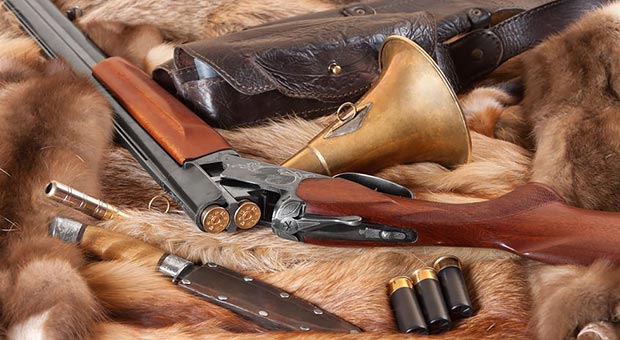Hunting and fishing are the bread and butter for all survivalists out there. Besides being a very enjoyable activity for your spare time, hunting actually serves a purpose, i.e. putting food on the table in a survival situation.

Knowing how to hunt and how to field dress small/big game might really save your life at some point.
Now, dressing game is not the most pleasurable thing to do. But, you’ve gotta do what you’ve gotta do. I like rabbits too, but when it comes to survival, you know, better him than me!
Keep reading and I will try to share with you the main principles of the fine arts of hunting and field dressing. But you must remember that practice makes perfect, this is just a crash course in dressing game.
How to Field Dress an Animal
Use Clean Instruments!
One of the most important things to remember, if you field dress animals/birds/fish, is that there is a risk of contaminating the meat with food-borne pathogens. For example, like any other kind of perishable meat, both raw and cooked game can be infested with dangerous bacteria, such as salmonellae or pathogens like E-Coli.
Unlike supermarket food that is tested for pathogens and is fit for human consumption (supposedly), game meat is another story; small/big game meat may contain parasites, the animal may be diseased, your guess is as good as mine where the animal has been and what it’s been exposed to prior to landing at the end of your skinning knife.
I know you all heard about hamburger meat infestation and stuff like that, so you know what food poisoning means. Therefore, you must be extra careful when handling the meat, especially when you’re in a real life survival situation and you don’t have access to medical services.
You must understand the dangers of gutting the animal incorrectly: there are blood-borne diseases/parasites and dangers associated withwild food, like warbles (a common parasite that is found in wild game) or Tularemia (rabbit fever). Also, the raw game meat must be properly cooked as soon as possible at a high enough temperature to destroy the potential harmful bacteria.
One of the crucial things when it comes to field dressing is to get a clean shot when killing the animal. If the bullet strikes the animal where it’s not supposed to, the internal organs may be mixed together; along with the hair, parasites may enter into the carcass.
Eviscerating
A well-placed shot into the neck or torso (heart) should do the trick and it will also bleed the animal out. Now, when dressing game, you must follow a few basic steps:
- use clean water at all times
- be careful and don’t t let mud inside the carcass; the same goes for leaves, twigs or other potential contaminants
- keep the carcass open using a clean stick
- always use a clean knife.
There are a few ways to field dress the game, but basically the first step is to eviscerate the animal as quickly as possible after the shooting. In this way, you will prevent the loss of body heat and also keep bacteria from multiplying on/inside the carcass. In order to reduce the risk of infection, you should wear plastic gloves while gutting the animal. If you don’t have disposable gloves, you should wash thoroughly with water and soap before and after the procedure.
In the beginning, you can spread the hind legs of the animal by propping a stick between them in order to open up the carcass. The carcass itself should be hung from a tree or fixed on its back, using logs or rocks to keep it steady.

If the animal is a male, you must first remove its genitals, but keep the scrotum for later sex identification. In case you shot a female, you must remove the udder first. It is recommended to make a small incision, in order to prevent insects or dirt from spoiling the carcass during transportation.
In the next step, you must use a well sharpened and clean knife to perform an evisceration cut, between the sternum all the way along, to a point near the scrotum/mammary glands.
You should lift the skin/muscle together while performing this cut, through the hide and the membrane.
You must try to avoid piercing the entrails and the intestines, because these areas are most likely to contain all sorts of bacteria associated with food borne diseases.
Between cuts, you should clean the knife frequently (using clean water or alcohol), to avoid the contamination of the meat with bacteria.
In order to successfully remove the entrails, you must perform a circular cut around the anus orifice to loosen it up so it will come out easily at the same time with the rest of the intestines.
Now, you can pull the entrails out, beginning from the crotch area. At the same time you must cut the tissue that connects the innards to the spine. In order to pull the entrails free, you must cut all the tissue that holds the guts inside the carcass and don’t be scared of the blood; it will be plentiful, but that’s normal.
The liver and the heart can be removed separately and placed in plastic bags as soon as possible if you like to eat organ meat.
After removing the entrails, you must clean the cavity thoroughly and drain the blood. All visible feces, dirt, hairs or bloodshot areas must be removed. The inside of the cavity must be wiped using paper towels or a clean cloth (you can rinse it with clean water also).
Once the field dressing is performed, you must remove the hide. If you plan to transport the animal, you may leave the hide on, because it prevents the meat from being contaminated during transportation. Also, leaving the hide on the carcass prevents the meat from drying.
Skinning
If you’re hunting small game, like rabbit or squirrel you can skin it prior to gutting it; things change radically when it comes to animals like deer or bigger. Still, if you’re transporting it, it’s better to leave the skin on.
Regardless of the animal, the principles of skinning are the same: first you cut around the head/neck of the animal to start skinning it. Slice through the hide but stop before slicing through the mea. Next you must remove the hide by tearing /cutting off the tissue that keeps it connected to the carcass.
Basically, you must peel back the skin/hide in both directions (along the evisceration cut), using your fingers and your knife when necessary. You must be careful not to let the hide to touch the carcass, as it may contaminate it. At the very least, it will get hair on the tissue that’s extremely difficult to remove.
In the end, you must remove the complete hide of the game so that you can access the meat and begin the butchering process.
That is, after all, the name of the “game” – FOOD!
This article has been written by Chris Black for Survivopedia.
Want to be as self-sufficient as possible? Want to master all the lost skills our grandfathers had? Then you really need this amazing step-by-step guide. It is called The Lost Ways and it contains all the knowledge of our forefathers.
Here’s just a glimpse of what you’ll find in The Lost Ways:
From Ruff Simons, an old west history expert and former deputy, you’ll learn the techniques and methods used by the wise sheriffs from the frontiers to defend an entire village despite being outnumbered and outgunned by gangs of robbers and bandits, and how you can use their wisdom to defend your home against looters when you’ll be surrounded.
Native American ERIK BAINBRIDGE – who took part in the reconstruction of the native village of Kule Loklo in California, will show you how Native Americans build the subterranean roundhouse, an underground house that today will serve you as a storm shelter, a perfectly camouflaged hideout, or a bunker. It can easily shelter three to four families, so how will you feel if, when all hell breaks loose, you’ll be able to call all your loved ones and offer them guidance and shelter? Besides that, the subterranean roundhouse makes an awesome root cellar where you can keep all your food and water reserves year-round.
From Shannon Azares you’ll learn how sailors from the XVII century preserved water in their ships for months on end, even years and how you can use this method to preserve clean water for your family cost-free.
Mike Searson – who is a Firearm and Old West history expert – will show you what to do when there is no more ammo to be had, how people who wandered the West managed to hunt eight deer with six bullets, and why their supply of ammo never ran out. Remember the panic buying in the first half of 2013? That was nothing compared to what’s going to precede the collapse.
From Susan Morrow, an ex-science teacher and chemist, you’ll master “The Art of Poultice.” She says, “If you really explore the ingredients from which our forefathers made poultices, you’ll be totally surprised by the similarities with modern medicines.” Well…how would you feel in a crisis to be the only one from the group knowledgeable about this lost skill? When there are no more antibiotics, people will turn to you to save their ill children’s lives.
And believe it or not, this is not all…
Table Of Contents:
Making Your Own Beverages: Beer to Stronger Stuff
Ginger Beer: Making Soda the Old Fashioned Way
How North American Indians and Early Pioneers Made Pemmican
Spycraft: Military Correspondence During The 1700’s to 1900’s
Wild West Guns for SHTF and a Guide to Rolling Your Own Ammo
How Our Forefathers Built Their Sawmills, Grain Mills,and Stamping Mills
How Our Ancestors Made Herbal Poultice to Heal Their Wounds
What Our Ancestors Were Foraging For? or How to Wildcraft Your Table
How Our Ancestors Navigated Without Using a GPS System
How Our Forefathers Made Knives
How Our Forefathers Made Snow shoes for Survival
How North California Native Americans Built Their Semi-subterranean Roundhouses
Our Ancestors’Guide to Root Cellars
Good Old Fashioned Cooking on an Open Flame
Learning from Our Ancestors How to Preserve Water
Learning from Our Ancestors How to Take Care of Our Hygiene When There Isn’t Anything to Buy
How and Why I Prefer to Make Soap with Modern Ingredients
Temporarily Installing a Wood-Burning Stove during Emergencies
Making Traditional and Survival Bark Bread…….
Trapping in Winter for Beaver and Muskrat Just like Our Forefathers Did
How to Make a Smokehouse and Smoke Fish
Survival Lessons From The Donner Party
Get your paperback copy HERE
CHECK OUR survival and prepping solutions
If you found this article useful, please like our Facebook page and stay up to date with the latest articles.
WHAT TO READ NEXT:
HOW TO MAKE YOUR OWN BACON (STEP BY STEP GUIDE)
A RETURN TO THE OLD PATHS: HOW TO MAKE PEMMICAN LIKE THE NATIVE AMERICANS
20 LOST RECIPES FROM THE PIONEERS: WHAT THEY COOKED ON THEIR JOURNEY WESTWARD
SEVEN CLASSIC GREAT DEPRESSION ERA RECIPES GRANDMA USED TO MAKE
POTTED MEAT: A LOST SKILL OF LONG TERM MEAT STORAGE
BACK TO BASICS: HOW TO MAKE AND PRESERVE LARD
THE BEST WAY TO STOCKPILE VEGETABLES OFF-GRID
OLD FASHIONED PRESERVING-GRANDPA’S RECIPE FOR CURED SMOKED HAM
HOW TO MAKE GUNPOWDER THE OLD FASHIONED WAY
SURVIVAL HERBAL RECIPES FROM OUR ANCESTORS
HOW TO PRESERVE MEAT FOR SURVIVAL LIKE OUR GRANDFATHERS
OTHER USEFUL RESOURCES:
The 3 Pioneer Survival Lessons We Should Learn
The Most Effective Home Defense Strategies
Old School Hacks for Off-Grid Living
The Medical Emergency Crash Course
The Smart, Easy Way to Food Independence
How to Survive the Coming 100 Years Long Drought
About Chris Black
Chris Black is a born and bred survivalist. He used to work as a contractor for an intelligence service but now he is retired and living off the grid, as humanly possible. An internet addict and a gun enthusiast, a libertarian with a soft spot for the bill of rights and the Constitution, a free market idealist, he doesn’t seem very well adjusted for the modern world. You can send Chris a message at editor [at] survivopedia.com.

One Reply to “How to Field Dress an Animal”